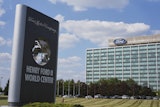
The $2.3 trillion manufacturing industry has come a long way from its roots hundreds of years ago, as companies around the world are increasingly more interested in encompassing sustainability in their operations and going green to benefit the health of our planet. In fact, 12.6 million deaths, caused by factors such as water pollution, chemical exposures, and more, could be prevented each year if we work to make our environments healthier.
According to a global survey, 69% of respondents in North America said it was extremely or very important for companies to prioritize improving the environment. And because the manufacturing sector has a sizable global footprint, it’s that much more critical for the industry as a whole to work toward implementing lasting recycling practices.
This kind of proactive approach for the health and safety for our planet isn’t necessarily new. A framework for the proper management of hazardous waste in industries like manufacturing was enacted in 1976 through the Resource Conservation and Recovery Act (RCRA). From this authority, the Environmental Protection Agency (EPA) established a comprehensive regulatory program to ensure that hazardous waste is managed safely from "cradle-to-grave," meaning from the time it is created until it is disposed of.
Manufacturing facilities often have the greatest potential for recycling and cost saving opportunities and many improvements have been made on behalf of the environment. There are still areas for growth, though, as some recycling practices are simply delayed or ignored completely. Here are three key steps and ideas to keep in mind when creating a plan to expand recycling in the manufacturing process and to create a lasting approach to sustainability practices.
Prioritize the Waste Profile Sheet
When choosing a hazardous waste management vendor, be prepared to fill out a critical hazardous waste profile sheet that will require a list of all chemical properties of the particular type of waste that is being produced. Once completed, the manufacturer’s vendor will then be able to identify what can be recycled and what can be used for waste to energy. Some vendors can then help guide the customer on what is recyclable and what is not in addition to providing guidance on how to best manage byproducts during the recycling process.
For example, customers might be using a particular solvent that includes a chlorinated compound that would eliminate it from being recyclable. To help avoid this situation, one recommendation for customers is to first reach out to the manufacturers of the chemicals to identify what materials are being used and what the alternatives might be, if needed, for recycling. This step alone can help streamline the recycling process, and in this example, identify a solvent that’s recyclable.
Identify Alternative Recycling Options
Initial questions that customers can ask of themselves include, “Are there materials being used that can be recycled downstream?” And if not, “Are there alternative recyclable materials?” When determining what products or materials can be recycled, it truly depends on what supplier is being used for materials. Some suppliers are focused on being green, so they might opt to ship their cargo boxes as opposed to transporting in plastic containers that may not be recyclable. Customers can work closely with their provider so they can choose the materials that would be best for recycling. With this proactive approach, they can see what the end result will be for the byproducts.
In addition, consider the potential complete reuse of byproducts. While materials might not be recycled back to their original form, there could be opportunities to reuse byproducts as an alternative fuel for a cement manufacturing plant, as an example. As manufacturers are continuously looking to expand their green footprint, aim to go the route of recycling material if at all possible as landfills and incineration should be a last resort option.
Implement a Day-to-Day Practice
Often, the best organizational external practices begin with internal implementation and improvements. Spend time examining operational products and materials like computers, bulbs, used paint and paper. For example, when computers are used, they eventually become outdated and are replaced. What is being done with old monitors, cables and switches? These kinds of recycling needs can also be discussed with the manufacturer’s vendor.
Manufacturers that encourage recycling among their staff could result in a practice that encourages them to bring in household products, like old batteries, to be recycled as well. Ultimately, having an economic sense is critical for manufacturers that place recycling and sustainability as a key goal.
As consumers and companies alike continue to prioritize sustainability, and many manufacturers aim to reduce carbon emissions or achieve zero emissions in the next decade or less, there are simple and often overlooked switches that can be made to both internal and external company practices. It is invaluable to lead the industry by example, showcasing how simple changes in routine can ultimately lead to an eco-friendly manufacturing facility.
Kurt Schmidt is the Regional General Manager for Clean Earth and has over 18 years of experience working for the Harsco Corporation. Clean Earth’s vision is to create a better future for our people, partners, and planet by turning specialty waste into recycling opportunities. It is one of the largest specialty waste companies in the United States, providing remediation, disposal, recycling, and beneficial reuse solutions for hazardous and non-hazardous waste and contaminated materials.























